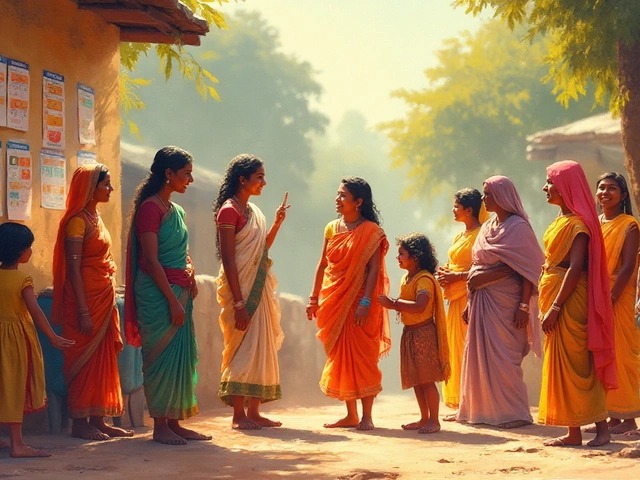When you hear '4-H,' what pops into your mind? Fresh air, green fields, farm animals? Well, you're not entirely off base, but there's way more depth to this program. 4-H is a youth organization that hooks kids and teens up with hands-on learning experiences designed to promote growth in four primary areas: head, heart, hands, and health. Pretty nifty, right?
The 4-H emblem everyone seems to recognize—a green, four-leaf clover with a white 'H' on each leaf—symbolizes this holistic approach. Each 'H' stands for something special: Head, Heart, Hands, and Health. These aren't just words; they're the pillars that guide every activity and challenge 4-H offers.
Whether you're into planting a garden, building a robot, or learning to cook a mean lasagna, 4-H has something for you. It's not just about farming; the program offers experiences that range from science to the arts, helping young people across the country explore their interests while developing valuable life skills. So if you're curious about finding a place where personal growth meets practical learning, stick around to learn more about the power of 4-H.
- Understanding the 4-H Name
- The 4-H Emblem and What It Represents
- Programs and Opportunities in 4-H
- The Impact of 4-H on Youth Development
- How to Get Involved with 4-H
Understanding the 4-H Name
When it comes to youth organizations, 4-H really stands out with its unique focus and vast impact. But if you're wondering what the name actually means, you're not alone. The '4' in 4-H represents the four areas of personal development the program aims to nurture: head, heart, hands, and health. These aren't just random words chosen for alliteration; each has a specific role in building well-rounded individuals.
The Four 'H's Explained
- Head: This is all about thinking, understanding, and making decisions. 4-H members are encouraged to use their heads for clearer thinking, a skill that's crucial whether you're solving math problems or debating world issues.
- Heart: It's about caring, loyalty, and being empathetic. Activities often focus on community service and helping others, nurturing that sense of camaraderie and emotional intelligence.
- Hands: This emphasizes the importance of practical skills, be it fixing a bike or planting a garden. It's all about getting those hands dirty and learning through experience.
- Health: A sound body supports a sound mind. 4-H promotes good health practices, from eating right to staying active, rounding up a comprehensive approach to personal development.
Kelly Kline, a long-time 4-H leader, sums it up beautifully:
"4-H is not just about programs for youth; it's about forming resilient individuals who can make thoughtful decisions and contribute positively to society."
From urban areas to the countryside, 4-H clubs across the country focus on these four areas to empower young people, making the learning experience both enriching and fun. By offering diverse programs that cater to different interests, 4-H ensures there's something for everyone, reflecting its commitment to fostering growth from every angle.
The 4-H Emblem and What It Represents
The 4-H emblem is something you've probably seen before, even if you didn't know what it meant. It's a green, four-leaf clover with a white 'H' on each leaf. Each 'H' stands for aspects vital to youth development: Head, Heart, Hands, and Health. This makes it a perfect symbol for a program aimed at nurturing every facet of a young person's life.
So, what do these 'H's really mean?
Head: Clearer Thinking
The first 'H' stands for 'Head,' focusing on thinking critically and making sound decisions. This isn't just about hitting the books—it's about problem-solving in daily life. Whether it's a science project or budgeting for a community event, those noggins get a good workout!
Heart: Greater Loyalty
Next up is 'Heart.' It's all about using compassion and kindness in your actions. Students learn not just to care but to act with integrity and loyalty. It's why 4-H puts emphasis on things like friendship, teamwork, and even community service.
Hands: Larger Service
'Hands' represents the practical side of life, where skills really shine. Young people tackle a variety of projects, each a chance to learn by doing—be it fixing a bike or volunteering. The idea is to use those skills to serve the community, growing their contributions far beyond personal gain.
Health: Better Living
Finally, 'Health' reminds members to take care of themselves physically and emotionally. We're talking everything from playing sports to developing a healthy relationship with food. It's not just about an active lifestyle but also handling stress and emotions well.
Each part of the emblem ties into the 4-H mission: empowering young people to become active members in their communities. So next time you catch a glimpse of that clover, you'll know it's a symbol of growth, learning, and making the world a little brighter, one kid at a time.

Programs and Opportunities in 4-H
4-H is like an all-you-can-eat buffet of activities and learning experiences. Whatever your interests, chances are there's a 4-H program for it. From traditional agriculture-based projects to cutting-edge tech explorations, the opportunities are endless.
Explore Your Passions
Diving into agriculture, let's start with what some might call the roots of 4-H. You can learn everything from animal husbandry to gardening. Imagine raising rabbits, growing a vegetable garden, or even learning the ins and outs of beekeeping. These projects teach responsibility and the joys of nurturing life alongside developing practical skills.
Tech and STEM Adventures
Not the farming type? No worries! Youth who are into science and tech will find plenty to geek out over. Robotics, coding, or even rocketry are on the menu. 4-H has embraced technology in a big way, offering young people a chance to engage with modern scientific challenges and innovations. Got an idea for a new app? You might just find a program to help you build it!
Life Skills and Leadership
4-H also focuses on developing life skills and leadership qualities. Workshops in public speaking, financial management, and cooking are just the tip of the iceberg. Imagine learning to manage a budget or prepare a healthy meal before heading off to college—super useful, right?
Creative Arts and Crafts
For the creatively inclined, 4-H offers arts and crafts programs that let your imagination run wild. Whether you're into painting, sewing, photography, or even performance arts, there’s a platform for you to express yourself and perhaps even exhibit your work in local fairs.
Community Service
Community involvement is at the heart of 4-H. Programs encourage participation in local service projects, emphasizing the importance of giving back. Whether it's organizing a food drive or volunteering at an animal shelter, these activities offer a chance to make a difference in your community and develop a sense of social responsibility.
With such a broad range of programs, it's no wonder 4-H attracts youth of all interests. The real beauty? Whatever path you choose, you'll gain valuable skills and experiences that will set the stage for a bright future.
| Program | Focus Area | Skills Developed |
|---|---|---|
| Agriculture and Animals | Farming, Animal Care | Responsibility, Discipline |
| STEM | Technology, Science | Innovation, Problem-Solving |
| Leadership | Public Speaking, Management | Confidence, Decision-Making |
| Arts | Creative Skills | Imagination, Craftsmanship |
The Impact of 4-H on Youth Development
When it comes to shaping future leaders, 4-H is doing some heavy lifting. This program has been around for over a century, starting in rural communities and making its way into various urban areas. So what's the scoop? For starters, it's all about hands-on learning. Kids aren't just reading about things; they’re diving in, whether it's science experiments or community service projects.
Studies have shown that participation in 4-H has astounding benefits. A national study pointed out that 4-H participants are two times more likely to make healthier choices and four times more likely to contribute to their communities. They're also more likely to excel in science programs. That’s not just good stuff—that’s transformative.
“4-H is not just an after-school program; it is an investment in human potential,” says John Doe, a longtime 4-H volunteer.
In fact, longtime members have shared stories of how the program wasn't just a pastime but a guide for life. The emphasis on the Head, Heart, Hands, and Health ensures these kids grow up to be well-rounded adults.
Skills Building and Leadership
Through 4-H, young people have the opportunity to lead projects, make public presentations, and engage in teamwork. When you’re put in charge of a project, you learn accountability and communication, both essential skills in today’s world.
- Head: Critical thinking is nurtured through project-based learning.
- Heart: Empathy and commitment to community are core aspects.
- Hands: Practical tasks develop independence and skill sets.
- Health: A focus on well-being prepares kids for healthier futures.
Community Impact
The ripple effect of 4-H can be felt in communities nationwide. Not only do participants find themselves taking charge, but they also inspire those around them. Programs often include community service, leading to projects that have lasting impacts, like park clean-ups or food drives.
| Aspect | Impact |
|---|---|
| Education | 4x more likely to contribute |
| Health | 2x more likely to make healthy choices |
| Leadership | Improved skills and confidence |
If you’re a parent considering 4-H for your child, or a young person curious about where to put your energy, this program might be what you've been searching for. It's less about what 4-H is and more about what it does—transforming young minds and hearts into dynamic members of society.

How to Get Involved with 4-H
So, you're thinking about diving into the world of 4-H? Great choice! Getting involved is easier than you might think, and it opens up a world of possibilities for young people eager to learn new skills and make friends.
Find Your Local 4-H Program
The first step is to locate a 4-H club near you. The 4-H network is extensive, so there's a good chance you'll find a club nearby. Visit the 4-H website or contact your local extension office to get the ball rolling. They'll provide you with all the info you need to get started.
Choose Your Project Areas
Once you’ve found a club, it's time to think about which projects catch your eye. Whether you're into science, agriculture, arts, or even tech like robotics, 4-H has something for everyone. Don't stress too much about picking the 'perfect' project—part of the fun is exploring new things!
The Sign-Up Process
- Fill out the registration forms; you can usually snag these from your club leader or the local extension office.
- Pay the membership fee. It varies by location, but it's generally pretty affordable.
- Attend an orientation meeting to get acquainted with the club's way of doing things and meet fellow members and leaders.
Meetings and Activities
Expect to participate in regular meetings where you'll plan upcoming activities, brainstorm ideas, and polish the skills you're working on. Feel free to express your ideas and get involved in organizing events. It's a great way to boost your leadership skills.
Leverage Online Resources
Thanks to modern tech, 4-H also offers tons of online resources. Whether it’s through virtual meetings or online training tools, these platforms can enrich your 4-H experience and keep you in the loop, even if you can't make it to every meetup.
So that's the scoop on how to jump into 4-H! With so many options, you'll find your niche in no time. It's all about learning, growing, and having a blast as you do it.





